Top Ten Home Energy Checklist (AE1442, May 2018)
Availability: Web only
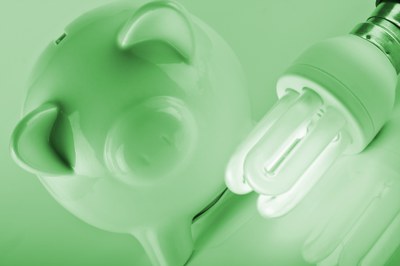
“How much energy is my home wasting?”
Going Green may be the driving force for you, with continued connections being made between global climate change and energy; many people are looking to reduce their energy use because it is the right thing to do for individuals and our planet. Buildings use 71 percent of the electricity produced and almost 50 percent of all energy consumed in the United States.
Whether trying to save money or save natural resources, concentrating on the areas of the home that are the largest energy consumers or areas for energy waste makes sense. Each home is different, but this guide will provide some direction for where to concentrate efforts to reduce energy consumption. Ask yourself each question and see if you can determine the answers to reduce energy use.
1. How does my home compare with state standards, or what is its rating number?
Many organizations and utilities are offering home energy audits and ratings that will identify the energy efficiency or energy rating of your home. The purpose is to compare your energy use with other similar homes to determine if you have areas where energy reductions will be cost effective. Check with your utility provider to see if it offers such a service. Another option is to perform an energy audit on your own home. The home energy saver Web site is a great resource for homeowners to determine their energy consumption.
2. Are the foundation, walls and ceiling in my home properly insulated?
Since home heating and cooling is the largest percentage of energy use for most homes, this has the potential for the largest energy savings. The 2006 International Energy Conservation Code (IECC 2006) recommends an insulation value of R-30 in the ceiling for homes in the southern U.S and R-49 for homes in northern climates. This is roughly 10 to 16 inches of insulation, depending on the type. If you have less, consider adding more insulation.
In northern climates, other than ceiling insulation, basement and rim joist insulation could be one of the easiest ways to reduce heat loss and pay for itself in a year or two in savings.
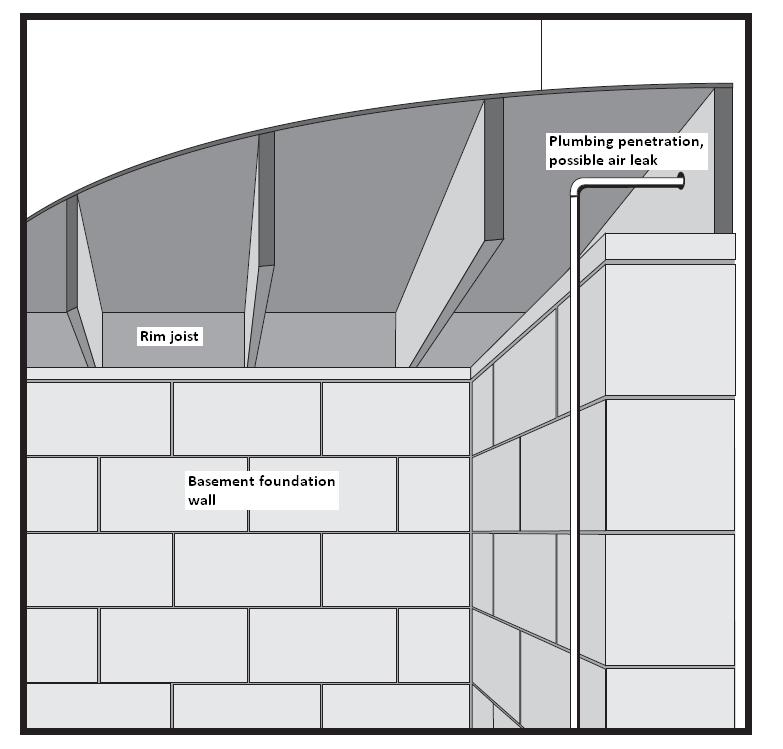
Areas that are often not insulated and overlooked for heat loss and air leaks.
3. Does your home have air leaks?
Air leaks carry a large amount of heat. A home that is not sealed properly will allow heat to leak in or out, depending on the season. Look for areas where leaks can occur, such as cracked or missing caulking around doors and windows. Plumbing, heating or electrical equipment that passes through the house also is an area to check for air leaks. Fiberglass insulation is a good insulator but poor air barrier, so dirty fiberglass insulation is a good indication of air leaks.
Air leaks can be found in a home using a number of techniques. Infrared cameras will show places in a home where air is leaking, but homeowners can use things as simple as an incense stick, a flashlight or even the back of their hand to search for air leaks.
NDSU Extension has developed a program using infrared thermometers to check for air leaks in a home. The infrared thermometers are available for loan from county offices of NDSU Extension, and information on areas in the home to check will be provided.
In addition to heat losses, leaks in a home can lead to problems with insects and moisture.
4. How old is your furnace?
Take a quick look at your furnace. If it was manufactured before 1992, replacing it with a new higher-efficiency furnace most likely would save you money. Furnaces with a large vent to allow fresh air for combustion air and a chimney for exhaust gases are called draft inverter furnaces and generally are, at best, 60 percent efficient. So, 40 percent of your heat bill is simply wasted to the outdoors. Newer furnaces are up to 96 percent efficient, meaning only 4 percent of the heat is lost through the exhaust. Most heaters will have a yellow ENERGY GUIDE label that will provide information on the energy use.
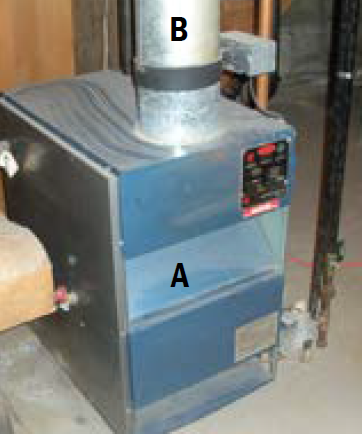
Draft inverter furnace. Note the large opening for intake air (A) and large galvanized pipe for exhaust air (B)
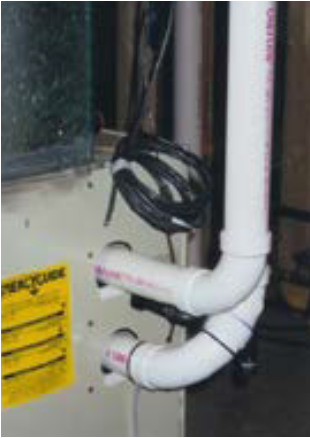
High-efficiency furnaces utilize PVC pipe for intake and exhaust air. The heat is retained in the furnace for distribution to the home and does not escape out the exhaust.
5. How much energy are you wasting from heating water?
You have a number of ways to minimize energy waste from water heating. First, check the temperature of your hot water; if it is above 120 degrees Fahrenheit, you can save money by lowering the temperature. Mark the present setting with a permanent marker and turn it down a little at a time to minimize the impacts until water at the taps is 120 degrees.
Next, feel the water heater. If it is warm to the touch, it is wasting heat. Installing an insulated blanket could pay for itself in savings in as little as one year. Check with the instruction/installation manual or manufacturer to ensure the safety of installing insulation on your model of water heater.
Low-flow shower heads are another great way to reduce home energy use. Newer shower heads significantly reduce water usage and provide a comfortable water pressure. Pipe insulation and heat traps can be used to reduce heat losses. Heat traps are simple backflow valves or loops that keep the hot water from slipping back into the water heater.
Wash clothes in cold water or use ENERGY STAR washing machines and dishwashers.
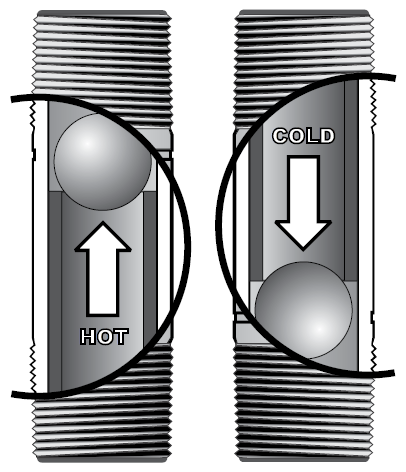
Heat traps with gravity-operated check values prevent convection heat loss due to circulation of hot water in the pipes above the water heater.
6. Do you set back your thermostat?
Turning down the heat or air conditioning at night and while you are at work or using a programmable thermostat in your home can have significant savings.
According to the U.S. Department of Energy, you can save 5 percent to 15 percent per year on your heating/cooling bill by turning your thermostat back 10 to 15 degrees for eight hours. That’s a savings of as much as 1 percent for each degree if the setback period is eight hours long. If your normal heating costs are $1,500 per year, that is a savings of $75 to $225 every year.
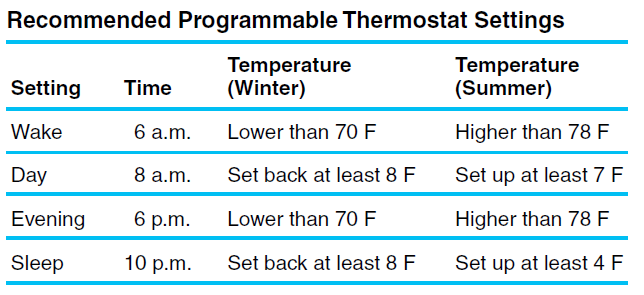
7. How efficient is your lighting?
The best way to save money and natural resources is to not use energy. The simplest way to reduce energy with lighting is to turn lights off when not in use. For lights that are being used, ensure energy-efficient light bulbs are installed. Compact fluorescent light bulbs use up to 75 percent less energy than incandescent bulbs and last much longer. Use natural lighting when possible. Homeowners pay for the watts used, so the lower the watt rating on lighting devices, the less they have to pay to use them.
8. Are the appliances in the home energy efficient or ENERGY STAR rated appliances?
Each appliance you purchase has two price tags, the first one is the initial cost and the second is the cost to operate the appliance. When looking at new appliances, ensure they are ENERGY STAR rated. Once installed, the only costs that a homeowner can influence are the costs to operate.
Ensure appliances are properly maintained and operating. Clean refrigerator coils periodically. Clean filters regularly and ensure seals on appliances, such as refrigerators, are working properly. Replace refrigerators that are more than 15 years old. New ENERGY STAR refrigerator models use about half of the energy than refrigerators made before 1993. Check for listings of rated appliances.
9. Are your landscaping and personal habits minimizing your energy use?
Cover windows with insulated drapes or blinds to reduce heat transfer, making the home more comfortable in summer and winter. Open window coverings on the sunny side of the home in the winter to allow the sun to heat your home for free. In the summer, use the window coverings or leafy trees to shade your house. If possible, plant a windbreak on the north side of the home to reduce the impacts from winter winds. Plant deciduous trees to prevent sunlight from hitting the house in the summer to reduce the cooling load.
10. Are the windows at least double-paned or glazed, and is more than 20 percent of wall space taken up with windows?
Even the most energy-efficient windows cannot match a properly insulated wall, so excessive amounts of glass in a house can reduce the energy efficiency and increase heat transfer. Double- or triple-glazed windows are more energy efficient than single-glazed windows as long as they are installed properly. Either plastic or glass storm windows can cut heat transfer through windows in half and reduce air leakage, which is a major cause of window-related heat loss. Window films are also another option to reduce heat transfer through windows.
11. Bonus: Does the home have a heat or energy recovery ventilator (HRV/ERV)?
Newer homes that are properly sealed may retain excess moisture and pollutants in the home. A heat or energy recovery ventilator can remove the moisture and pollutants while retaining the conditioned air in the home.

(May 2018)

